I started writing this piece a while ago, but now as we all stay home for the good of the world, I feel like this is more relevant than ever. Some of the routines I chose here involved visits to museums, parties, and entertaining guests in general, I tried to stay as accurate to them as I could at the time. But now, when we must practice social distancing, I hope you will find that most of these routines can be easily adapted. I hope this helps you if you are just starting to work from home now, or if you just need a little extra inspiration.
I have been working from home for a few months now, and, like everyone else in this same situation, can tell you work is not regular. Sometimes you find yourself full of ideas, inspired and with piles of offers, clients, and articles, but most days, that’s not the case. It seems that no matter how hard I tried, I could never find a schedule that worked for me. Either I would procrastinate my work until it seemed I had enough of it to justify my anxiety, or I would neglect my health, work nonstop, eat crappy food, and not leave the house for days. So, during one of the weeks I was feeling particularly uninspired, I decided it was enough, and I went to look for advice from experts. More specifically, I started to research how the hell have all of the artists and writers in this world managed to work better? And can their routines help me?
So, I set out to learn and follow the routines of five writers for five days. First, I had to narrow down my list. I had two criteria: the schedules would have to be different enough from each other, so this would not be repetitive, and they would have to be achievable within my means.
This research and idea mainly flourished through reading the book, Daily Rituals: Women at Work by Mason Curey. I highly recommend checking it out if you are looking for some creative inspiration. The main goal I hoped to get from this experiment was to develop a routine in writing and working from home that could develop into a habit, while getting closer to writers I admire and learning how to approach writing as a full-time job.
A Writer’s Work Week: 5 Days as 5 Authors
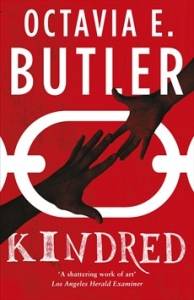 Day 1: Octavia Butler (Read: Kindred)
Day 1: Octavia Butler (Read: Kindred)
Octavia Butler’s drive and philosophy towards the role of the writer made her schedule the perfect one to start with. I chose to follow her post-publication of Kindred routine, in which she began to work as a writer full time and quit the menial jobs she detested so much. She woke up at 5:30 a.m., took care of necessary chores around the house, like dishes and breakfast, and then wrote, no matter what, until 9:00 a.m.
She famously said “F* inspiration,” and truly believed that the craft of writing, like any other, demanded not just passion but most of all, perseverance. So, with my alarm set to 5:30 and an enthusiasm to start the project the next day, I went to sleep. Well, I didn’t actually because I started to get so excited, then I got anxious and couldn’t sleep. When 5:30 came around, I promptly snoozed it until it stopped, and I slept until 8:00. I had already failed my project, and it hadn’t even started! So, I eventually got up feeling like a zombie and got ready for the day.
As I sat down for breakfast with my computer open and some tea, I looked out the window and thought to myself: How the hell did Octavia Butler do this? Needless to say, the answer is quite obvious: she had no other way. Butler worked in factories for most of her life, for which she had to wake up very early, and from which she came home very tired. So, the only moment she had to write was in the early mornings.
Another vital aspect of Butler’s work philosophy was how she approached writing. She believed it was something one must do if one has a calling. Inspiration be dammed, the writing was a job one was chosen for, and thus you needed to rise to its level. By the time I left for college, I had realized that no one is genuinely destined for anything. People work for it or are just very lucky. Plus, I overthink every type of creative work I do, because I don’t necessarily feel my work is “good” in any way. After all, I don’t feel a “calling.” Butler seems to have been the complete opposite of that. Her origin story as an author is in itself full of self-confidence. She saw a terrible movie when she was 9 and thought she could write something much better. So she did. And she did that without a supportive family, and worked tough and thankless jobs, up until her 30s when she became a full-time writer.
Butler saw herself as “A pessimist if I’m not careful, a feminist, a Black, a former Baptist, an oil-and-water combination of ambition, laziness, insecurity, certainty, and drive.” She was a phenomenal artist, and it is because of her stories and her self understanding that I was inspired to start this experiment with her routine. She was proud of her work and to be a science fiction pioneer. Her self-recognition and unapologetic attitudes towards her work is something I definitely could learn from. She seemed like she was very grounded, both in her work and herself. Something I think a lot of the artist tropes never really address, to the detriment of future creative hopefuls.
Unfortunately, her schedule did not really work for me. Still, maybe even because it did not work for me, I was able to spend my day researching Butler. Watching and reading interviews with her, and that was definitely a great creative and personal masterclass to me.
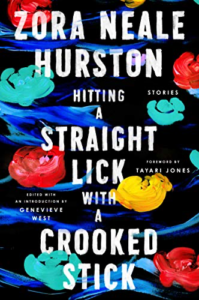 Day 2: Zora Neale Hurston (Read: Hitting a Straight Lick With a Crooked stick: Stories from the Harlem Renaissance)
Day 2: Zora Neale Hurston (Read: Hitting a Straight Lick With a Crooked stick: Stories from the Harlem Renaissance)
I chose Zora Neale Hurston for the second day. Both because she was a fiction writer and academic, and her approach to work is very similar to what I already practice. Yeah, I sort of took a break with this one, okay?!
I read Their Eyes Were Watching God when I was around 17, as a non-native English speaker; it was a tough book to read at first because of the southern dialect it is written in. But once I got the hang of it and started hearing the characters’ voices in my head, it became one of my favorite books of all time. Hurston had a very different life than Butler and, thus, a very different work philosophy. She was an academic and spent most of her time reading, researching, and writing about the topics she was working on, and spent very little time writing the essays and works of fiction she would become known for. A remarkable presence in the Harlem Renaissance, she was a multifaceted intellectual that believed in furthering her community.
Hurston used to dedicate herself to her academic work much more than her creative writing. She famously only wrote fiction when inspiration stroke. In her time, she was better known for her work in anthropology and folklore. For instance, when she wrote Their Eyes Were Watching God, she was extremely dedicated to her research on Haitian culture and religion. From the get-go, this seemed like the perfect work philosophy for me, maybe because that’s basically what I do most of the time.
When I do most of my work, I don’t really have a lot of attachment to it, because most of it involves research and non-creative writing. I can sit down and write several pages in a few hours once I have the information down, but when it comes to creative writing that’s another story. I have major writer’s block when it comes to fiction, and from everything I’ve read, that was the case for Hurston as well.
That day I had several errands to run, but I also got a lot of time in between them for reading. I read a lot about her. I read about writing and was able to do a lot of work that day. Inspiration never showed up, but I did try to work on my side projects in the meantime. However, nothing good came out of it, and I just went back to writing for work and researching, feeling a bit defeated. As I said before, this day was sort of a break because Hurston’s philosophy and workday is very similar to mine already. It works, but not as well as I would like it to.
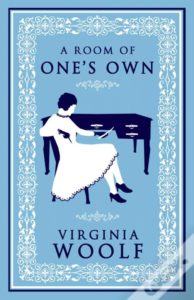 Day 3: Virginia Woolf (Read: A Room of One’s Own)
Day 3: Virginia Woolf (Read: A Room of One’s Own)
Virginia Woolf’s schedule is probably the most well documented of all the writers in this list. She was very vocal about prioritizing her work. Because of her extensive letter and journal writing, we can now see a full picture of her work life.
She had a structured day throughout, first working on her fiction between 10:00 a.m. and 1:00 p.m., and then breaking for lunch. Woolf’s afternoons were dedicated to letter writing and journaling, and in the evenings she would either entertain (if she had guests) or read until she went to sleep. This might seem quite uncomplicated, but knowing now what we know about Woolf, this regiment was something of a necessity. She dealt with a lot of anxiety and depression. So this structure helped her feel more grounded. That, combined with her economic situation, allowed Woolf to be free from the constraints a woman in her position had at the time, like house chores or social engagements. The truth is that Woolf did not like company a lot and found guests distracting to her true passion for her work. E.M. Forster famously said she was a terrible hostess, “giving her guests way too much space and free time,” which I find quite funny.
Overall, day three was quite successful, although I did take some liberties. I don’t have a room of my own in the apartment I share with my partner. Since both of us were working from home that day, I decided to go to my local library, which has a great view of the museum garden it’s located in. In the morning, I worked on my creative project and wrote for work. But mostly, I kept switching back and forth, which I think Woolf wouldn’t necessarily approve of as a creative practice. After 1:00 p.m. I took a break for lunch, as instructed. It was nice to have a specific time in which to eat because I am quite bad about holding on to an eating schedule and tend to just eat when I’m hungry…or rather, when I’m bored.
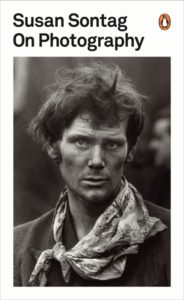 Day 4: Susan Sontag (Read: On Photography)
Day 4: Susan Sontag (Read: On Photography)
Sontag was famously 1000 people in one. She was an academic, intellectual, author, artist, mother, and generalized extrovert. When I first started researching her, I have to confess, I was exhausted. Staying still was not her thing. Susan Sontag was the kind of person who had a hunger for life; she wanted to experience everything all at once. She rarely wrote, but she partied, watched movies, and read; “a book a day was not too ambitious for Susan” was famously said by one of her friends. She did all of that as a single mother, and she was everything but conventional.
So, first, I needed to figure out what I could do. My social life isn’t nearly as impressive as Sontag’s, and frankly, I am very much an introvert, something she wasn’t. However, one thing she and I had very much in common is that we find writing to be very hard. Unlike some of the other authors here who were almost superhumanly disciplined about their craft, Sontag was a famously slow writer. She actually mentioned several times throughout her life how hard the act of writing was for her. She once took six months to write five essays for her book On Photography. She also famously did not leave her desk for three days in a writing trance so powerful that her then 10-year-old son would light her cigarettes for her so she would not stop writing. Yeah, the woman was intense.
Let’s just say that I am a bit thankful that I am not as exciting as Sontag. But because she is such a remarkable character, I wanted to see what I could take from her routine as inspiration. I decided to focus on a straightforward thing that seemed to inform Sontag’s life: never be bored. I could not go to a massive party with a bunch of intellectuals or find time to get tickets to see a play. So I decided to try to absorb a considerable amount of information and media for inspiration.
In the morning I went to the cafe near my house. I sat at the counter inside, ordered a pastry and coffee and began to read. I had brought On Photography with me. My goal was to accomplish at least one part of Sontag’s routine: reading an entire book in one day. Sontag apparently read at least one whole book every day, and what title more fitting than her most famous book of essays? I lost myself in it, reading and annotating in the margins, occasionally popping my head up from the book to people watch, trying to sync my mind with Sontag, attempting to have some insight into her thought process. After a couple of hours, I went back home and continued reading.
A few hours went by, and I started to feel hungry again. Sontag famously did not cook. She once said, “I never cooked for [my son] David. I only heated things up for him.” I can definitely relate to that. However, I went a little bit further. Inspired by Sontag’s extroverted spirit, I decided to take myself out for lunch. Again with On Photography under my arm and a notebook. I had a late lunch date with my partner, both of us reading and occasionally interrupting the other person to discuss this or that passage, this or that philosophical observation. He has been a fan of Sontag for years and was particularly happy that I was reading her essays. He decided to reread his favorite collection of hers: Regarding the Pain of Others, that day too. It was a perfect afternoon. We slowly walked back home, stopping by a few window displays of art galleries, antique shops, and a few little boutiques.
The last half of that day was supposed to be dedicated to actual socializing, meaning beyond my household sphere. But as fate would have it, the play we wanted to go see was sold out, and all of my friends were preoccupied with other things. So, I decided to watch a foreign film at my house. The specific movie that my partner and I chose was In The Mood for Love by Wong Kar-Wai. Sontag loved foreign films. Specifically Asian cinema, and I had been meaning to watch Kar-Wai’s now-iconic film for ages, so now I had no excuses.
The main take away from day 4 was that Sontag had a very particular approach to work. Somewhat loose and chaotic, it indeed worked for her, but I doubt that it can work for most people. It certainly did not work for me. As much fun as it was, I found myself saturated by information, feeling like I did not have enough time to properly understand what I had just watched or read that day. It also defeated the primary purpose of this experiment since I did not get any writing done that day, and I, like my schedule, was more out of control than ever. Even so, I think it’s the kind of approach everyone should take once in a while. I would not recommend it as a routine, but it’s an excellent routine breaker.
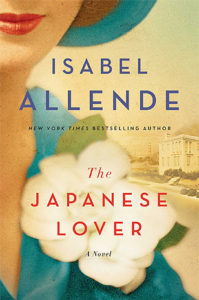 Day 5: Isabel Allende (Read: The Japanese Lover)
Day 5: Isabel Allende (Read: The Japanese Lover)
For the last day, I decided to go with the most structured schedule I could find, which luckily belongs to Isabel Allende. Allende has been very outspoken about her evolution as a writer and how her career has informed her routine. As a young author, Allende saw the destruction and exile of her family after her father was killed by Pinochet’s men in a military coup in Chile. She has stated that after that she fully understood that a writer’s work was dangerous and something that a person should never approach lightly. Writing was a higher calling and should be approached as such.
So, at the beginning of her career, Allende would stay up at all hours of the night, writing as much as she could after an exhausting day at work. It was in that tiresome and chaotic routine that she wrote The House of the Spirits, which propelled her success. Fortunately, that was a very long time ago. Now living in California with her dogs and husband, Allende has a more relaxed and structured routine around her craft.
Allende starts her day at 6:00 a.m., getting dressed (to impress, as she has noted) and drinking coffee with her dogs. From then on, she will write, disconnected from the wifi, until lunchtime. After a light lunch, she will go back to her office, and connect her computer to the wifi to do mundane tasks (like emails), research, and attend meetings. It is also important to note that Allende takes at least two walks a day with her dogs. Since I don’t have any dogs, I just made myself a snack and took a stroll listening to an audiobook.
Overall, this was the most manageable schedule for me. Maybe because the day before had been so unstructured that the very regimented day was precisely the push my creativity needed. I wrote a lot that day and got a lot of things done for other jobs I had going on that day as well. I think that the most significant change were the walks. They truly helped. I rarely go out and wander, I tend to just not leave the house a lot, to be honest. Just being disconnected and able to wander around my neighborhood was an excellent way to clear my head. If you don’t want to go on walks or can’t, any way to just leave your work aside twice a day really helps. And I don’t mean go on Instagram or watch Netflix. Truly just move from where you work to another space and sit and listen to some music or just drink some tea or coffee, which can be a great way to restart your creative brain.
Conclusion
Overall I think this experiment was a success. I loved trying to put myself in the shoes of different authors that have inspired me. And even if I didn’t get to only eat oysters and champagne for a day (like the author of Out of Africa, Isak Dinesen) or lay in bed with chocolate bonbons (like French author Colette), it was still a lot of fun. Like expected, nothing was a perfect fit, but if I had chosen, Allende’s and Hurston’s schedules were the best for me, but we shall see as I go along. I highly recommend, especially in these times when we all have to stay inside, for you to try this experiment for yourself. There are a bunch of authors, artists, and thinkers with several different schedules you can get inspiration from. Just remember to be kind to yourself. Just because something worked for this one author you admire doesn’t mean that it will work for you. So, go look for some inspiration—you never know who will have the perfect schedule just for you!









